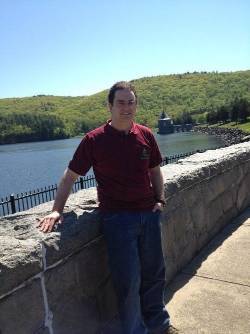Dr. George Hamaoui
Associate Professor, Biology

- george.hamaoui@mcla.edu
- Phone
- (413) 662-5169
- Office
- Center for Science & Innovation 225A
Education
Ph.D., University of Massachusetts-
Amherst, 2017
B.A., Ohio Wesleyan University, 2007
Courses Taught
BIOL 101: Biology Seminar for Majors
BIOL 150: Introduction to Biology I: Cells
BIOL 240: Genetics
BIOL 302: Applied Statistics in Biology
BIOL 480: Cell & Molecular Biology
PHED 215: Lifetime Wellness
Student Research Assistant
Research/Creative Interests
As a microbial ecologist, my research broadly centers on characterizing microbial communities (bacteria, archaea, fungi) and how these communities interact with each other in a variety of natural habitats. My graduate work consisted of understanding the effects of anthropogenic (human-caused) disturbance on soil microbial communities catalyzing the nitrogen (N) cycle. I worked with soil from two major disturbance experiments: the Amazon Rainforest Microbial Observatory (ARMO; Rondônia, Brazil) and the Soil Warming and N-Fertilization Experiment at the Harvard Forest Long-Term Ecological Research Site (Petersham, MA). These sites, experiencing stress from land-use conversion of rainforest to pasture and from artificial warming and N-fertilization, respectively, allow researchers to determine how human activities and climate change will affect the N-cycle, one of the most critical biogeochemical cycles in terrestrial ecosystems.
At MCLA, I have three major projects (for which I am always recruiting students!) centering on different aspects of microbial ecology:
1. Characterization of the bacterial microbiome of the orange-striped sea anemone Diadumene lineata (an invasive sea anemone expanding along the coasts of Massachusetts; project done in conjunction with Dr. Anne Goodwin, MCLA Biol. Dept.)
2. Characterization of the feather degrading microbial communities found on the plumage of local populations of Dark-Eyed Junco songbirds (Junco hyemalis; project done in conjunction with Dr. Dan Shustack, MCLA ENVI Dept.)
3. Establishment of DNA sequencing capabilities at MCLA using the Oxford Nanopore MinIon sequencing platform
Recent Presentations (*denotes undergraduate students)
Hamaoui Jr., G.S., Fachini, A.*, Billetz, A.C., Nielsen, H.*, Hilling, L.*, and Goodwin,
A.M. 2018. Bacterial Symbionts of the Sea Anemones Diadumene lineata and Exaiptasia pallida. NorthEastern Microbiologists-Physiology, Taxonomy, and Ecology Annual Meeting, Blue
Mountain Lake, NY
Hamaoui Jr., G.S., J.L.M. Rodrigues, B.J. Bohannan, J.M. Tiedje, and K. Nüsslein. 2018. Conversion of Tropical Rainforest to Pasture Causes Consistent Annual Shifts in Bacterial Community Structure and Biotic Homogenization. NorthEastern Microbiologists-Physiology, Taxonomy, and Ecology Annual Meeting, Blue Mountain Lake, NY
Hamaoui Jr., G.S., J.L.M. Rodrigues, B.J. Bohannan, J.M. Tiedje, and K. Nüsslein. 2015. Land-Use Change Shapes Archaeal Ammonia Oxidizing Communities in Tropical Rainforest Soils in Rondônia, Brazil. Applied and Environmental Microbiology Gordon Research Seminar and Conference, Mt. Holyoke College, South Hadley, MA.
Hamaoui Jr., G.S., J.L.M. Rodrigues, B.J. Bohannan, J.M. Tiedje, and K. Nüsslein. 2014. The Effect of Land Use Change on Ammonia Oxidizing Microbial Communities in Amazonian Rainforest and Pasture Soils. American Society for Microbiology annual meeting, Boston, MA.
Hamaoui Jr., G.S., S. Frey, J. Tang, and K. Nüsslein. 2013. The Effects of Warming and Nitrogen Addition on Nitrogen Cycling Microbial Communities in a Temperate Forest Soil. Soil Ecology Society biannual meeting, Camden, NJ.
Publications
Hamaoui Jr. G.S., J.L.M. Rodrigues, B.J.M Bohannan, J.M. Tiedje, and K. Nüsslein. 2016. Land-use change drives abundance and community structure alterations of thaumarchaeal ammonia oxidizers in tropical rainforest soils in Rondônia, Brazil. Appl. Soil Ecol. 107:48-56.
Rodrigues, J.L.M., V.H. Pellizari, R. Mueller, K. Baek, E. da C. Jesus, F. S. Paula, B. Mirza, G.S. Hamaoui Jr., S.M. Tsai, B. Feigl, J. M. Tiedje, B.J.M. Bohannan, and K. Nüsslein. 2013. Conversion of the Amazon rainforest to agriculture results in biotic homogenization of soil bacterial communities. P. Natl. Acad. Sci. USA 110:988-993.
